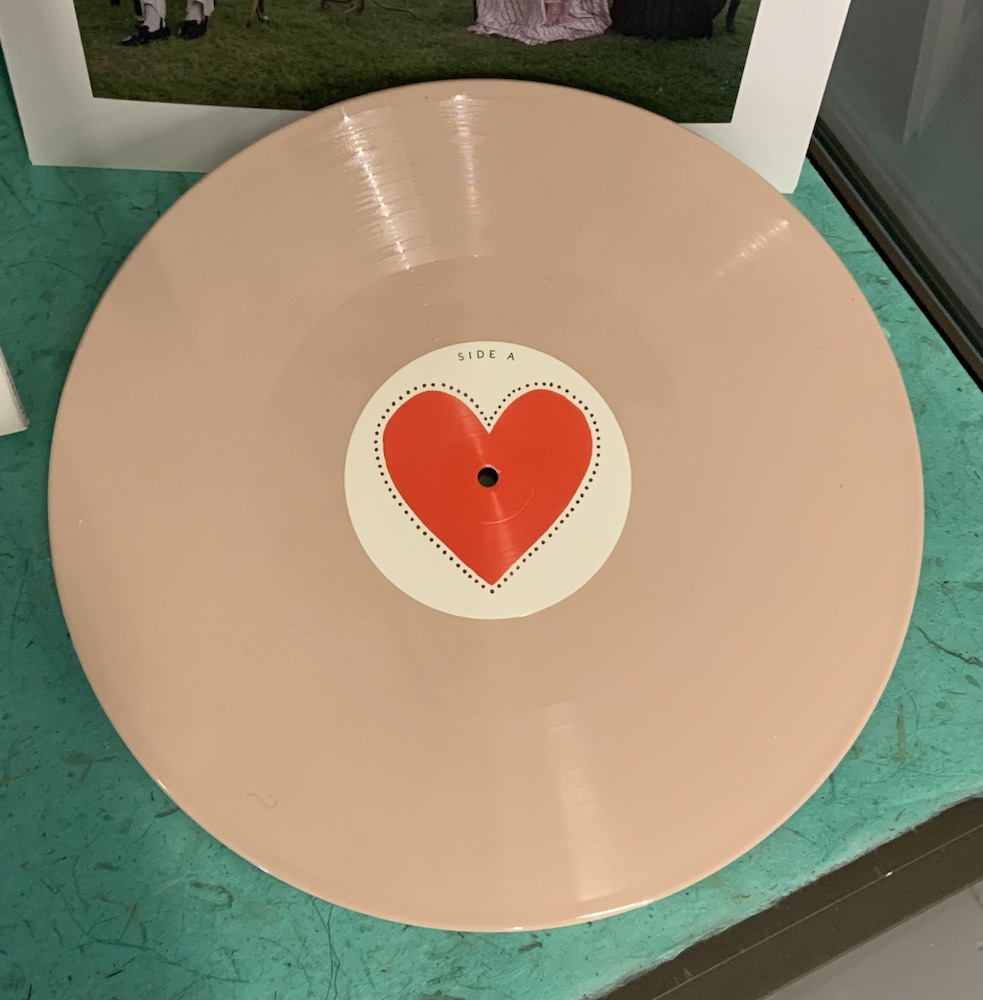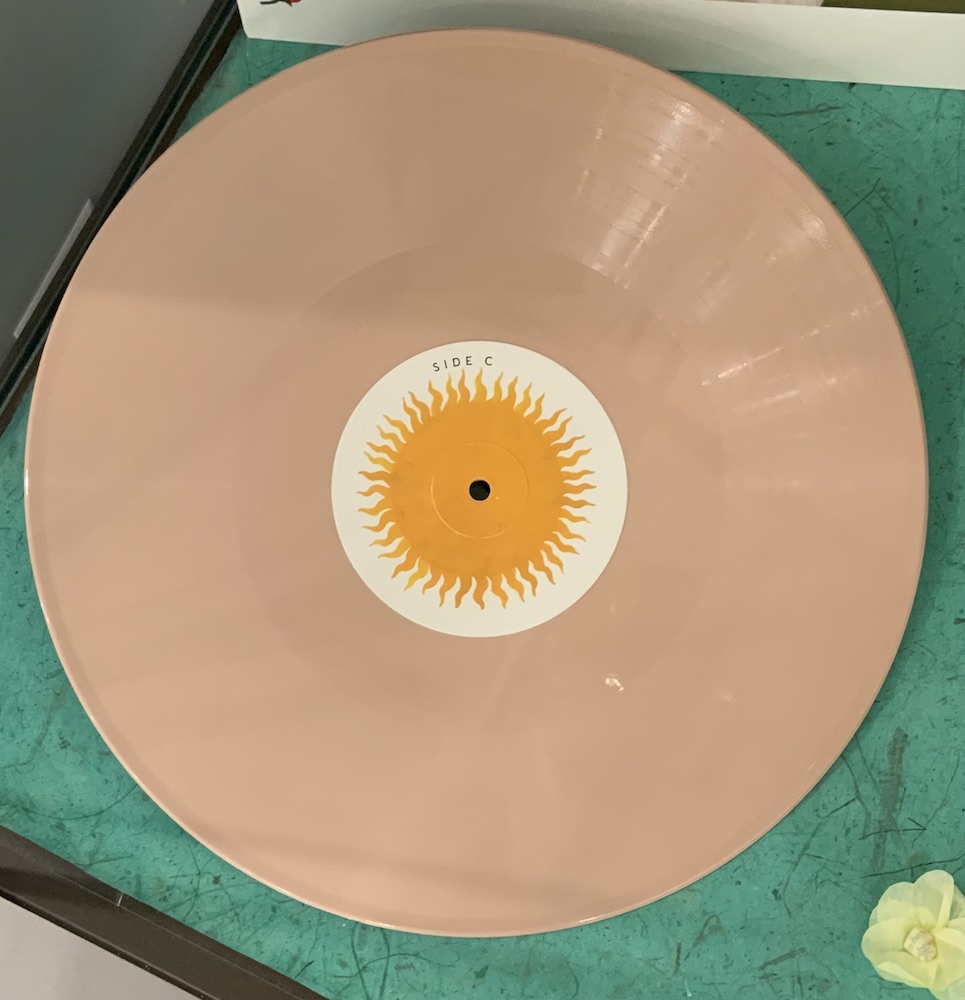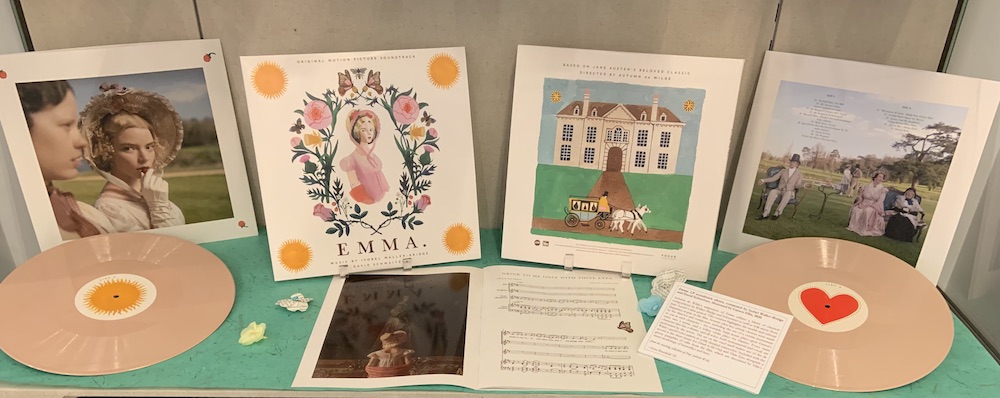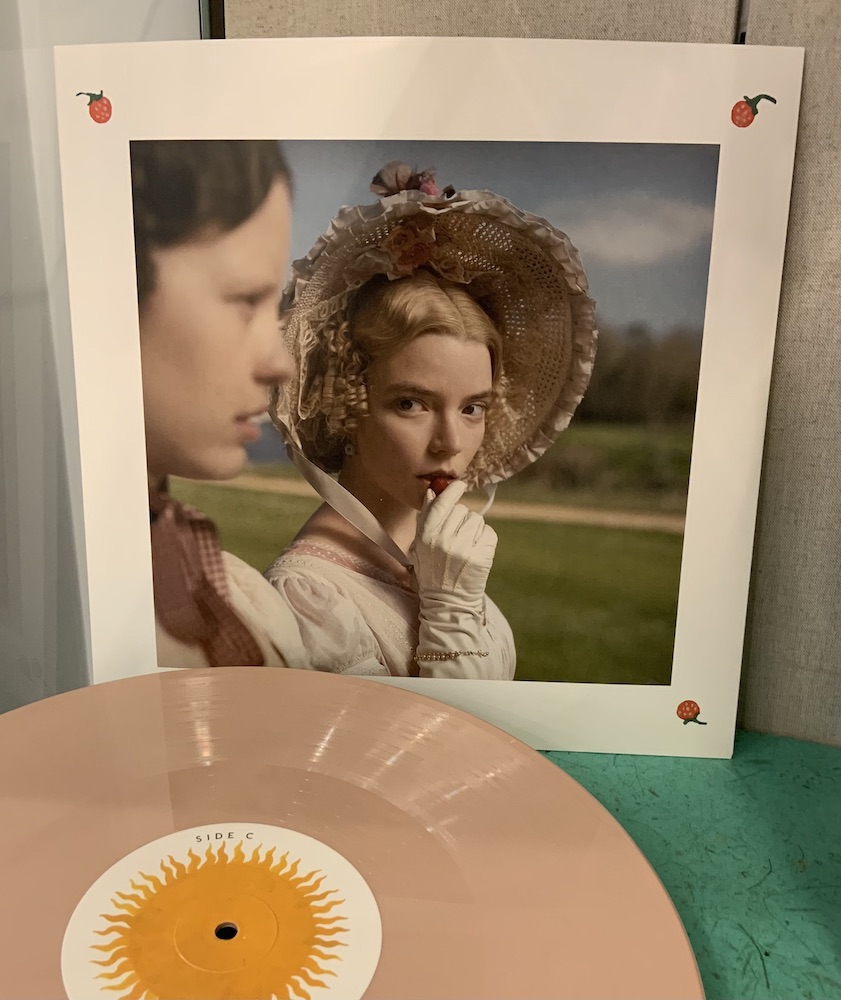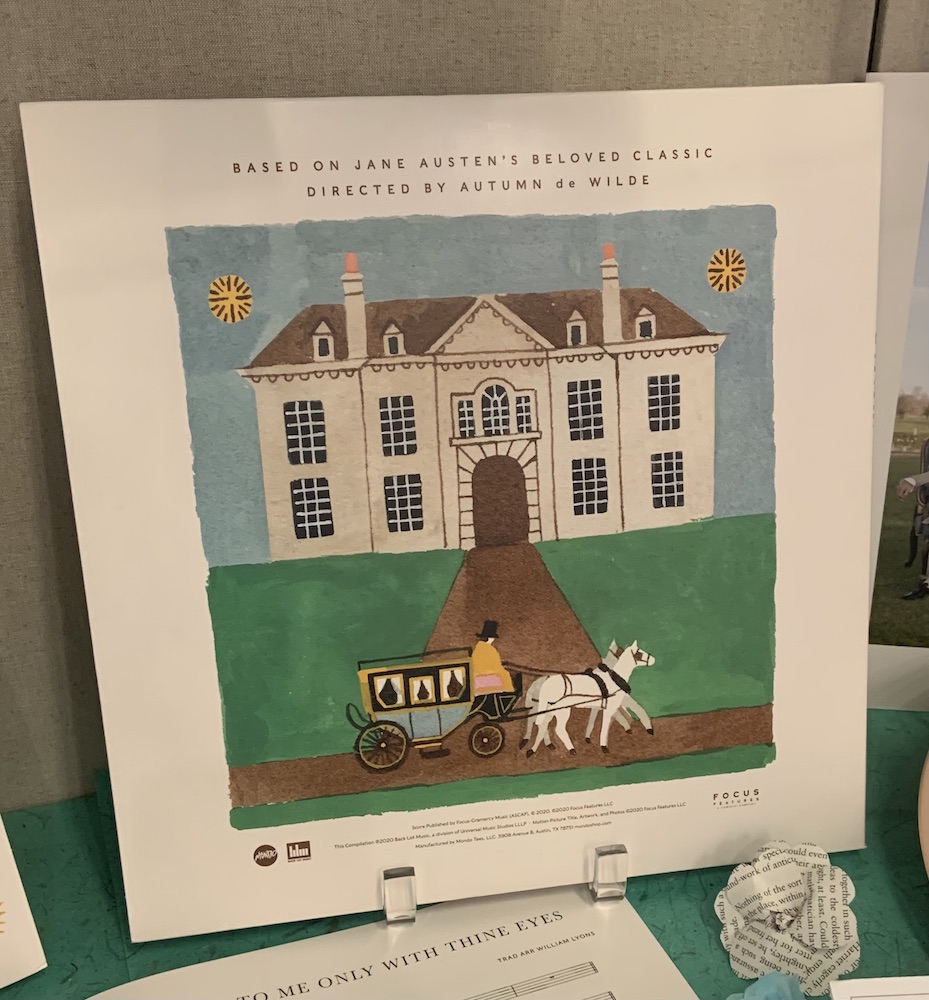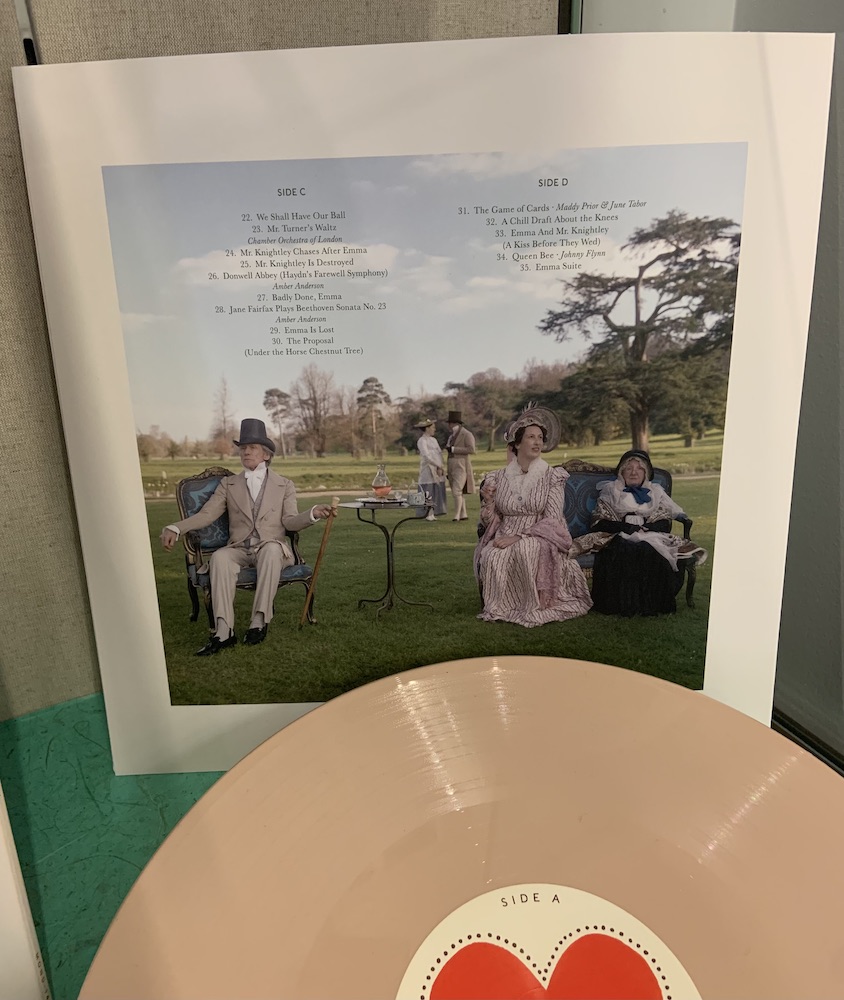Emma Across Other Mediums
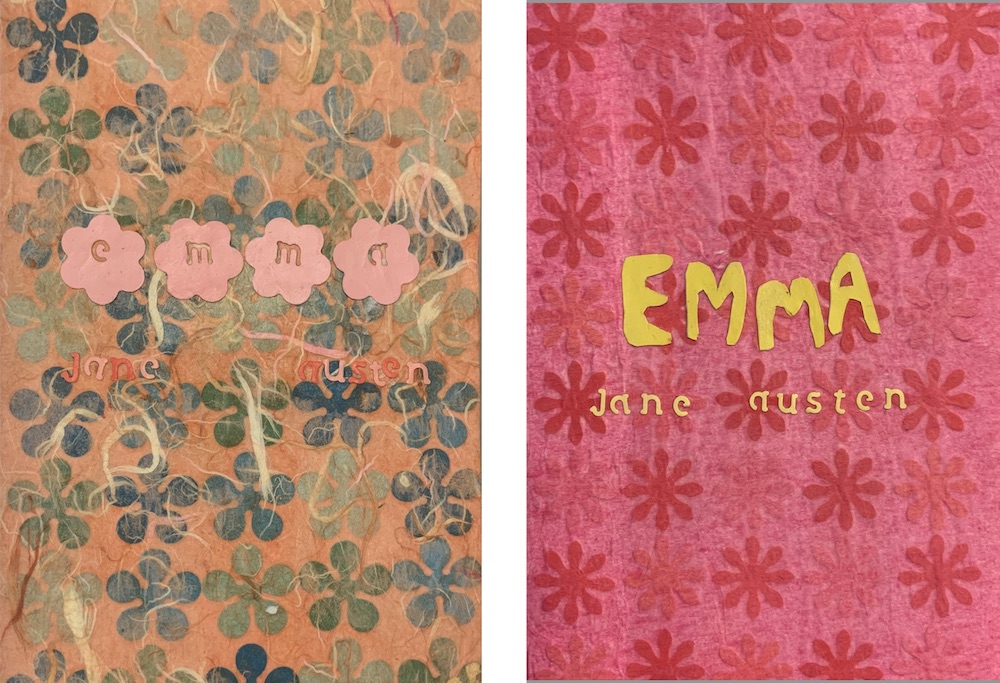
Emma art books by Clare Eloise Topping, 2023.
This set of covers were inspired by the many versions of Austen’s Emma in Goucher’s Special Collections and Archives, and the color scheme was influenced by the 2020 movie adaption by Autumn de Wilde. The original covers were painted with acrylic, collaged with flower cutouts, and enclosed with tissue paper.
–Clare Eloise Topping ’23
Regency-inspired bonnet. Katherine MacKie ’17. Created as part of a “Mobile Teaching Resource” as a course project for ENG 335: Jane Austen and Her Readers, fall 2015.
Katherine explained that she was motivated by “the desire to make Jane Austen accessible to middle and high school students…. These items are intended to be manipulatives, or things that the students can get up close and interact with.” She noted that “this particular bonnet is not very fancy, so it might have been worn by a middle-class woman. . . . Austen often talks of re-trimming her bonnets with new ribbons or trim in her letters to her sister Cassandra. . . . Bonnets are prevalent in Austen’s life and writing, so it is important to have at least a small understanding of what they looked like.”
from the teaching collection of Prof. Juliette Wells
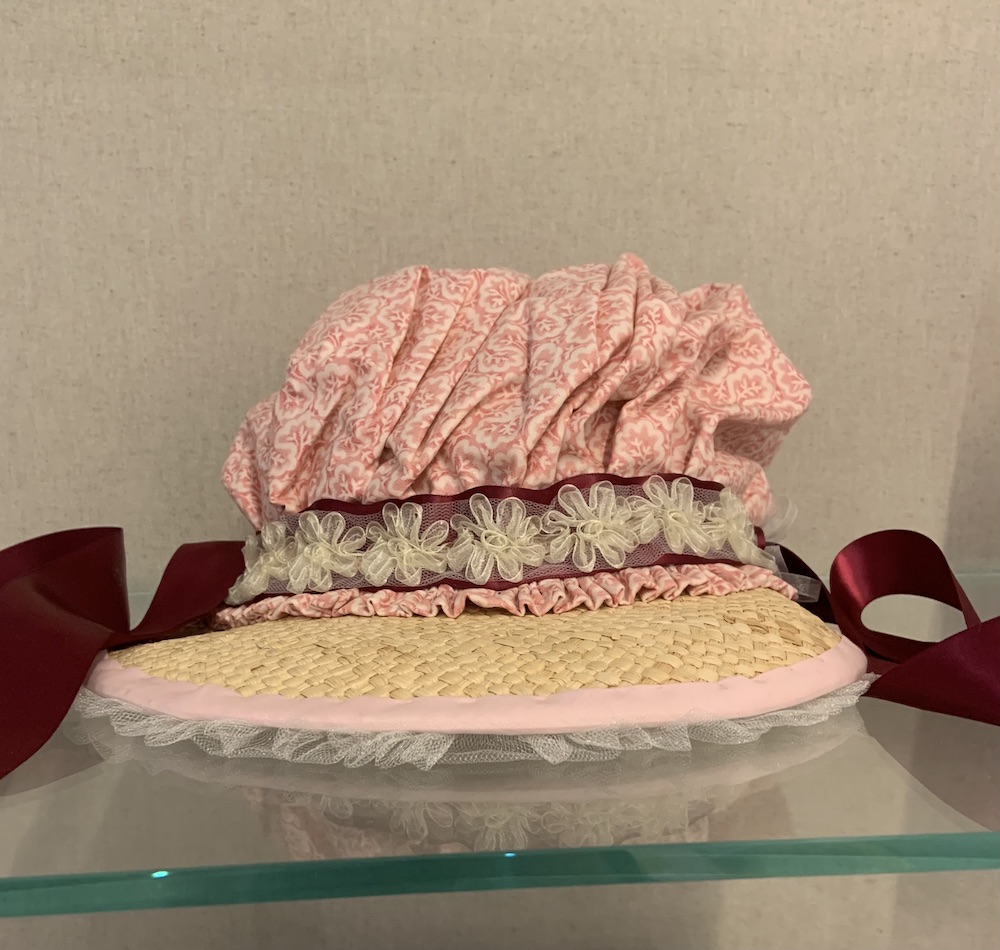
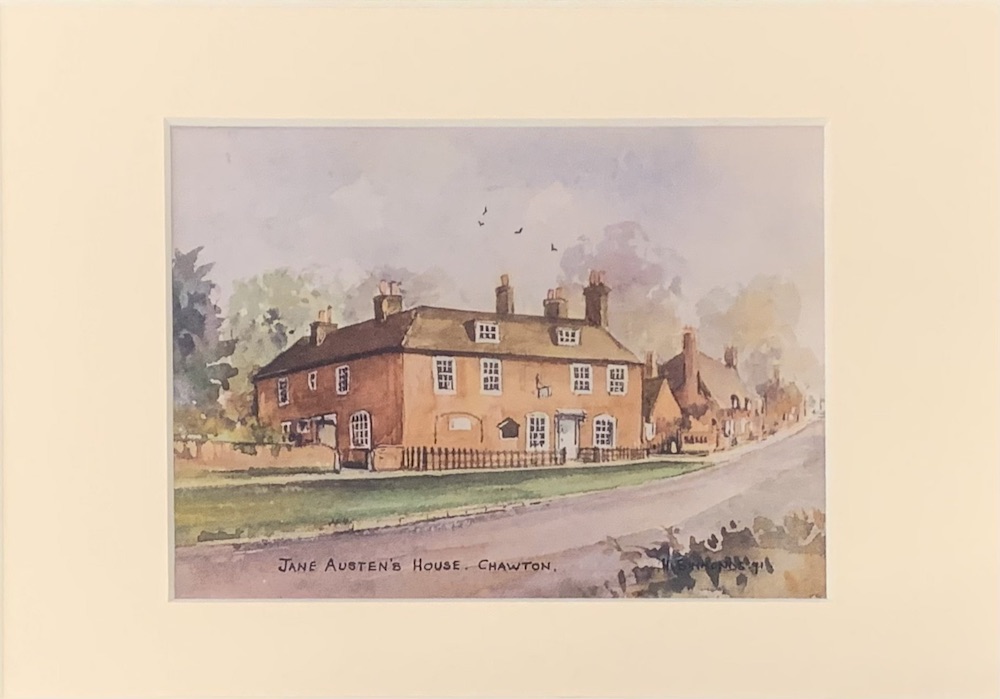
Print of watercolor depiction of Jane Austen’s House, Chawton, England.
Jane Austen’s House, formerly known as Chawton Cottage, was owned by Austen’s wealthy brother Edward Knight (né Edward Austen). There, from 1809 until shortly before her death in 1817, Austen lived happily with her beloved elder sister Cassandra, their widowed mother, and their dear friend Martha Lloyd. Alberta H. Burke often visited this house and was present when, in 1949, it was opened to the public as a museum. In May-June 2023, Lilia Gestson ’23 interned at Jane Austen’s House.
from the teaching collection of Prof. Juliette Wells
–Juliette Wells
Film still from Emma. (2020), directed by Autumn de Wilde, Focus Features and Universal Pictures, 2020. “Mr. Elton” sketch, created by and used with permission from Molly King ’23. Created 2023.
Selected from the online move database IMDb, this still shows Josh O’Connor as Mr. Elton, who visually feels like a pompous oaf before his true colors are revealed. Additionally, my talented fellow contributor Molly King has drawn a more disturbing vision of Mr. Elton based on this still. It aims to prove a point that the film’s costume designs reflect the personalities of the characters wearing said clothing
online databased IMDb and donation of Molly King
–Ian Meyer-O’Connor ’24
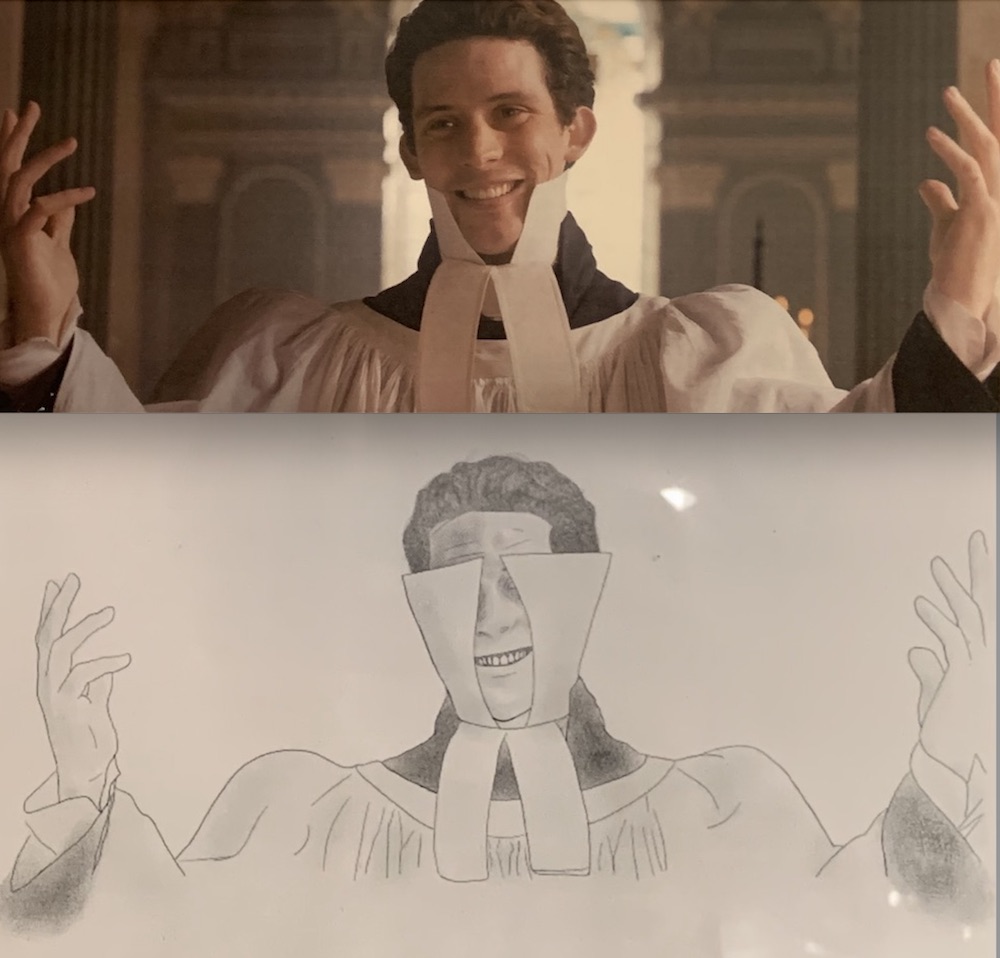
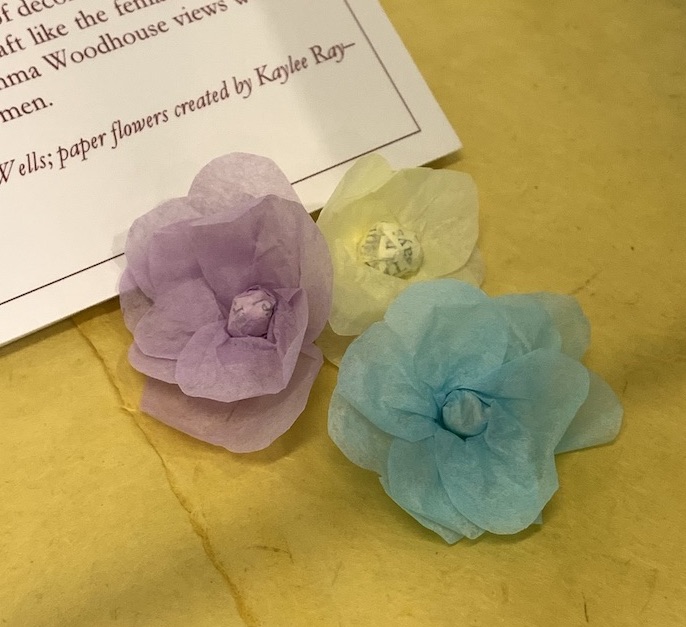
Austenian Paper Flowers derived from Jennifer Forest, Jane Austen’s Sewing Box. Murdoch Books, 2009.
In her craft book, Forest explores Regency era “women’s work,” described as a “creative outlet in the form of decorative art.” Forest gives 21st-century people the opportunity to craft like the female protagonists in Austen novels. In Emma, Emma Woodhouse views women’s work as a necessity to older, poorer women.
book from teaching collection of Prof. Juliette Wells; paper flowers created by Kaylee Ray–Williams
–Kaylee Ray–Williams ’25
Sophie Andrews. Hand-painted plates based on the patterns of wallpaper fragments at Jane Austen’s House, Chawton, England.
Andrews, author of the “Laughing with Lizzie” blog as well as the advice book displayed on this shelf, Be More Jane, created these plates with the permission of Jane Austen’s House. Painting on china was a typical “feminine accomplishment” of Austen’s era. Including in our exhibition decorative material from the house where Austen lived while writing Emma helps connect Goucher, the home for Jane Austen in America, with Austen’s actual writerly home in England.
from the teaching collections of Prof. Juliette Wells
–Juliette Wells

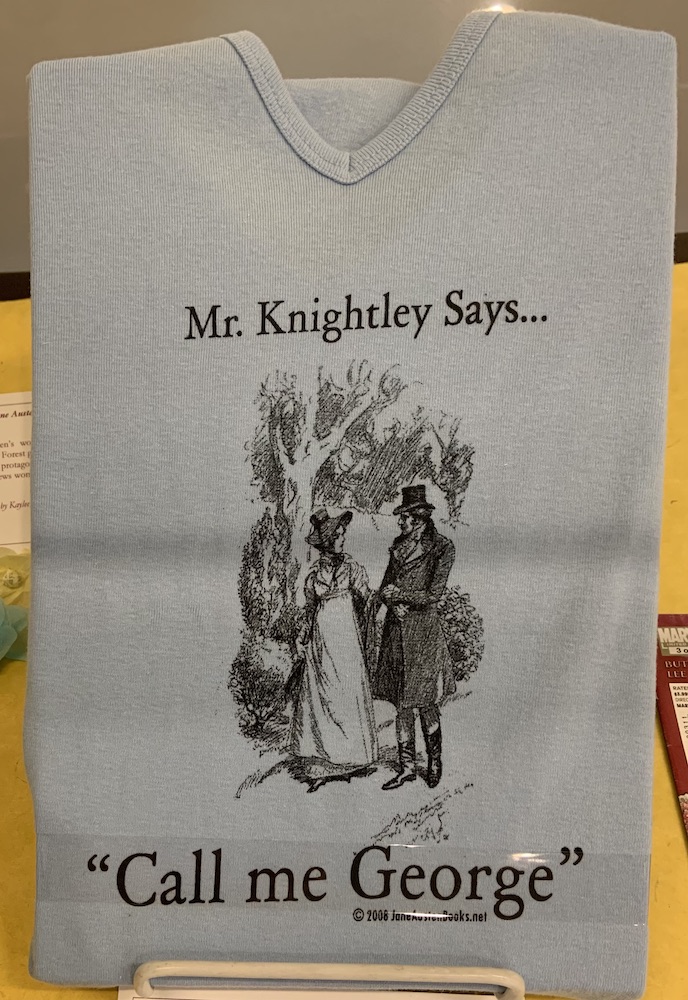
Emma T-shirt. Jane Austen Books, ©2008
Owned by Jane Austen Society of North America member Jennifer Weinbrecht of Ohio, Jane Austen Books is the only bookstore in the world exclusively focused on Austen’s life, works, and legacy. Accompanying a reproduction of a 19th-century illustration of Emma is a portion of Mr. Knightley’s question to Emma after she accepts his proposal of marriage: “And cannot you call me ‘George’ now?” She replies, “Impossible!—I never can call you any thing but ‘Mr Knightley.’”
–Juliette Wells
Tarot of Jane Austen, illustrated by Lola Airaghi, guidebook written by Diane Wilkes, 2007. Reading for the character of Emma by Lena Brazfield ’23.
This tarot set is composed of dainty pastel cards by Italian painter Lola Airaghi and an incredibly detailed guidebook by Certified Tarot Grand Master and Austen expert Diane Wilkes. Wilkes includes an introduction to reading tarot, synopses of all of Austen’s novels, storyline context and interpretations for each card, and original Austen–inspired spreads. The cards themselves depict important scenes from Austen’s works. This three-card draw was pulled on behalf of Emma as she prepares to wed Mr. Knightley and enter the next stage of her life, having learned a lot from the trials of the last year and her friendships with Frank Churchill and Harriet Smith.
from the teaching collection of Prof. Juliette Wells
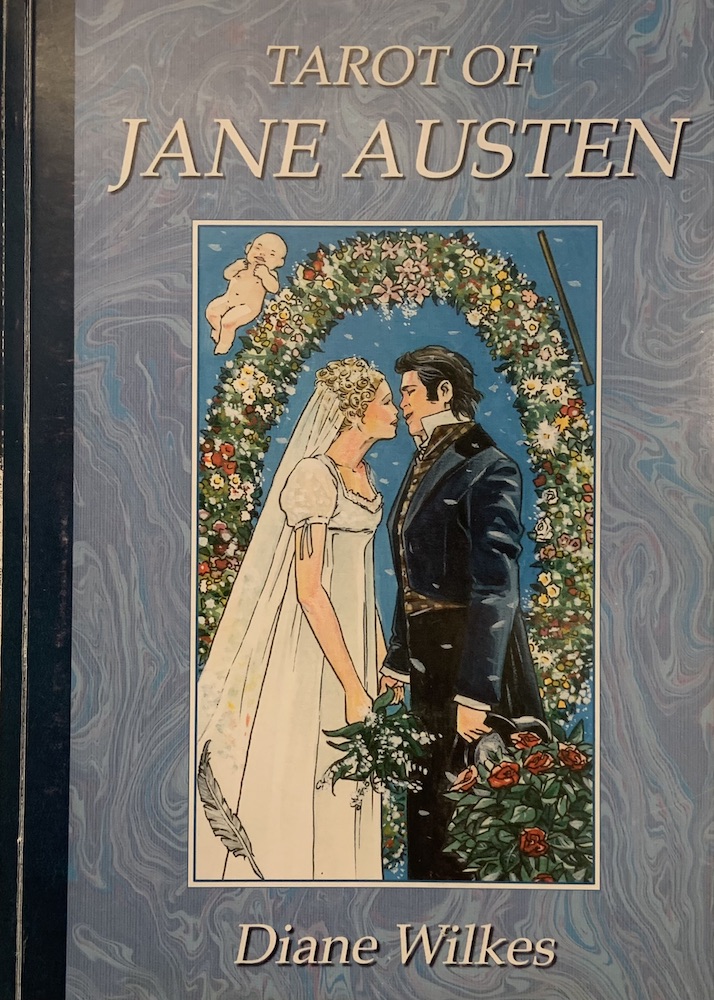
Card One ~ 2 of Quills. This card depicts Jane Fairfax, seated and preparing to write, between Mrs. Elton and Frank Churchill. The internal struggle of Jane, as she decides whether or not to marry Frank Churchill or become a governess to Mrs. Elton’s friend, conveys the weight of the decision in front of the reading-receiver (i.e. Emma). The 2 of Quills, akin to the 2 of Wands in traditional tarot, speaks to imminent transformation and current internal conflict. The 2 of Quills, akin to the 2 of Wands in traditional tarot, speaks to imminent transformation and current internal conflict.
Card Two ~ The Moon. This card depicts Emma gazing into her water basin at a vision of Mr. Knightley dancing with Harriet Smith. Harriet’s confession of her feelings for Mr. Knightley illuminated Emma’s underlying love for him, and she is now being forced to reckon with the consequences of not realizing her feelings sooner. The Moon represents mystery, sensitivity, and the subconscious.
Card Three ~ 7 of Teacups. This card depicts Harriet Smith, surrounding by the floating heads of the handsome gentlemen that occupy her daydreams. Harriet’s fickle and easily-influenced nature has led her to a place in which she has to evaluate her options more seriously and become aware of her penchant to romanticize. The 7 of Teacups, akin to the 7 of Cups in traditional tarot, represents both opportunities and delusion.
Interpretation
These three cards speak to a lot of uncertainty about Emma’s future and her marriage. In the novel, this is true in that she and Mr. Knightley must come to a big compromise about where and how they will live, as Emma has no intention of leaving her father, Mr. Woodhouse, to manage their estate by himself. Even their great happiness upon addressing the love between them must consider how Mr. Woodhouse will factor into their lives. This conflict is represented most distinctly by the 2 of Quills. However, between the Moon and the 7 of Teacups, there seems to be more at play. This is where a queer interpretation of Emma, the novel, might come in handy as a tool for reading this spread. Since her marriage to Mr. Knightley and Harriet’s to Robert Martin effectively ends the friendship between Emma and Harriet, these two cards may indicate the internal conflict of this parting. Something in Emma’s subconscious is having difficulties with this decision (the Moon), but she is deluding herself into complacency (7 of Teacups). Overall, this reading suggests that a key part of Emma’s marriage should be her independence, as this will give her the opportunity to come to terms with whatever she’s suppressing and make choices within her marriage accordingly. These uncertain circumstances lend themselves well to empowerment and positive change, if harnessed correctly.

Tweets from SparkNotes Twitter Account, 2022-2023
SparkNotes, a website providing accessible study guides from literary and philosophical texts, has a pithy Twitter presence that often utilizes present-day meme formats to discuss various works of classic literature. The tweets shown here overlay references to Emma on images from the popular television shown The Office and Brooklyn 99, and from the web-series Buzzfeed Unsolved.
–Lena Brazfield ‘23

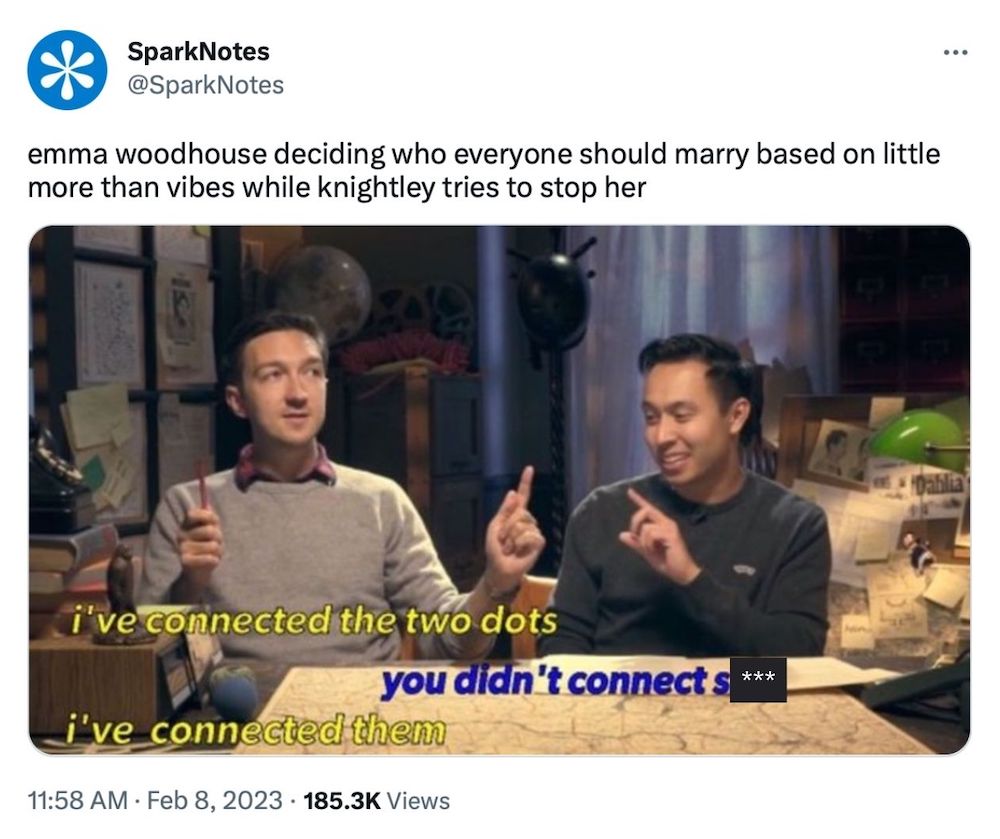
“Emma (2020) meets Clueless (1995),” Tumblr post, stills and quotes compiled and created by user miller–day. Tumblr, 2020.
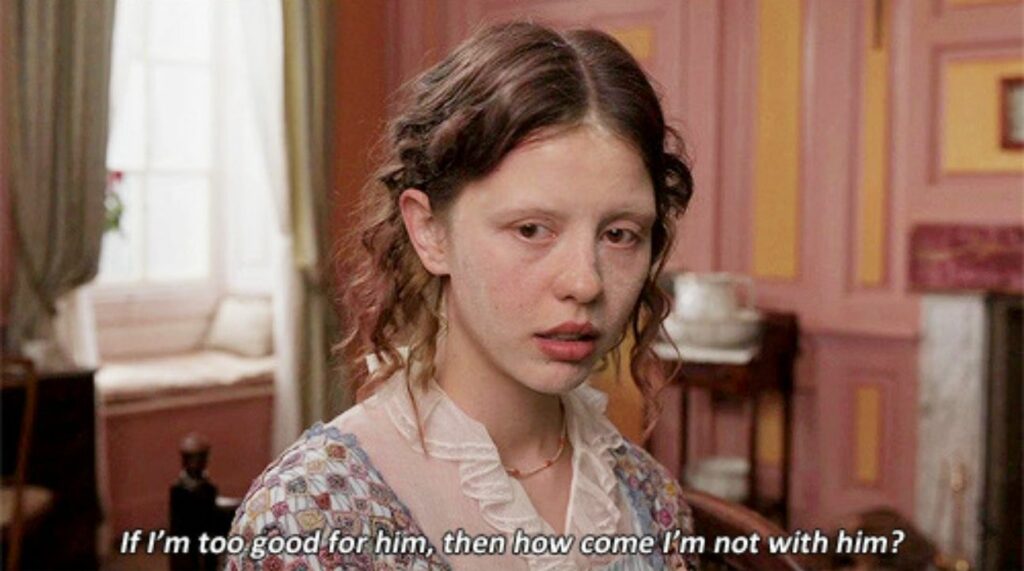
Though the term itself entered usage recently, memes are a form of media that have existed throughout history and have exploded in a variety of artworks, videos, and pictures edited with the (typical) aim of being funny. Seen here is the combination of dialogue from Clueless, an adaptation of Emma, posted over stills from 2020’s Emma. The result shows in some cases that both adaptations follow similar narratives, and in others creates humor showing how out of place one adaptation’s dialogue is in another’s for the same scene.
reshare of Tumblr posts, no affiliation to Goucher College
Ian Meyer–O’Connor ’24


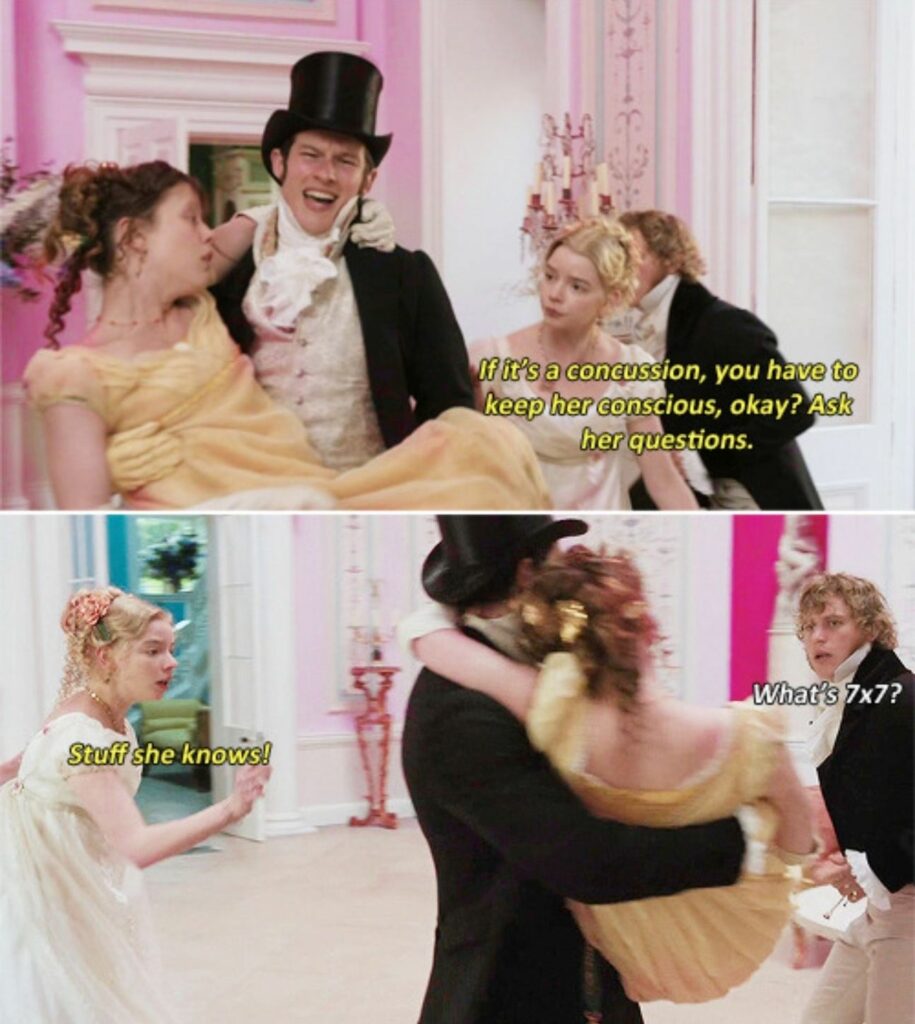
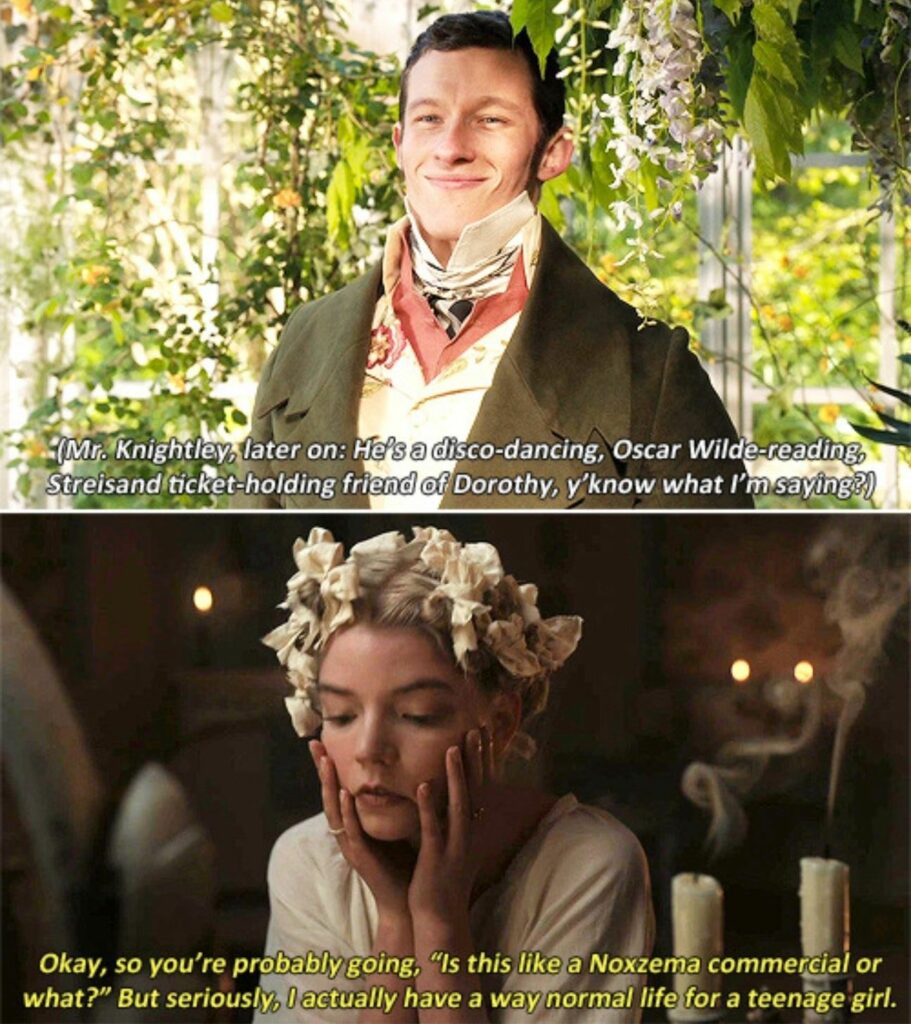
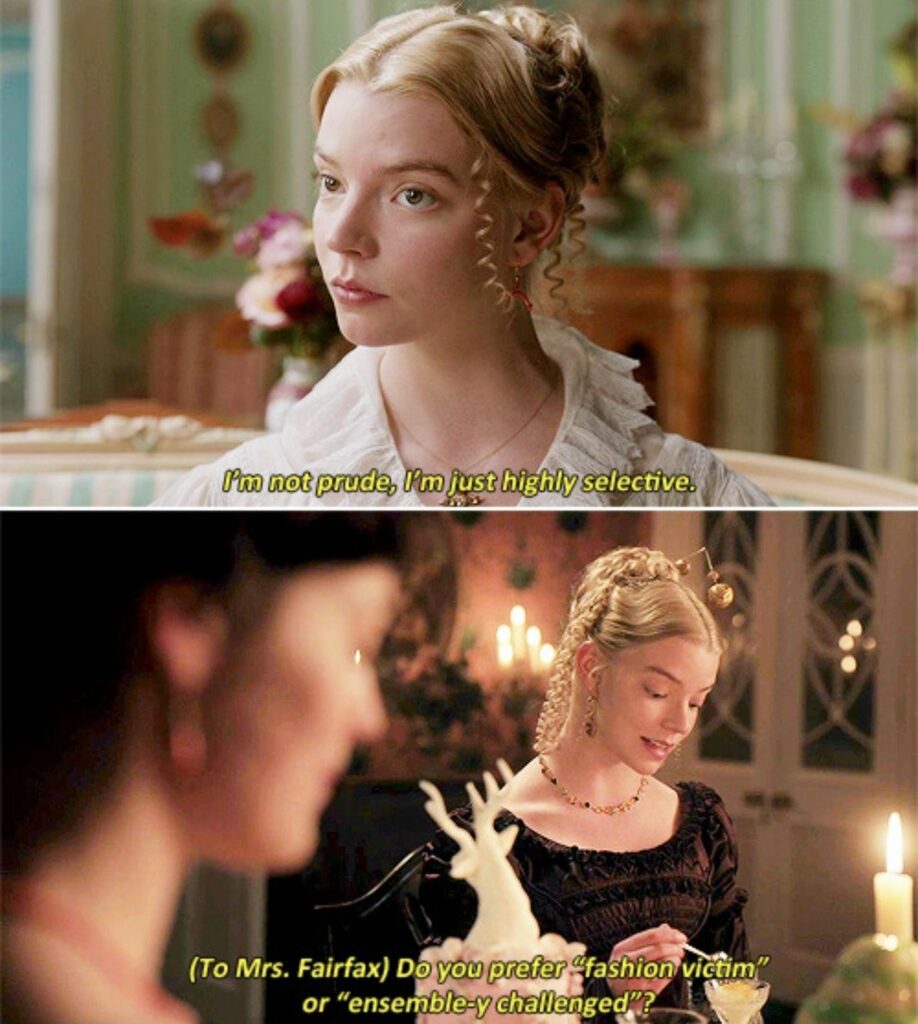
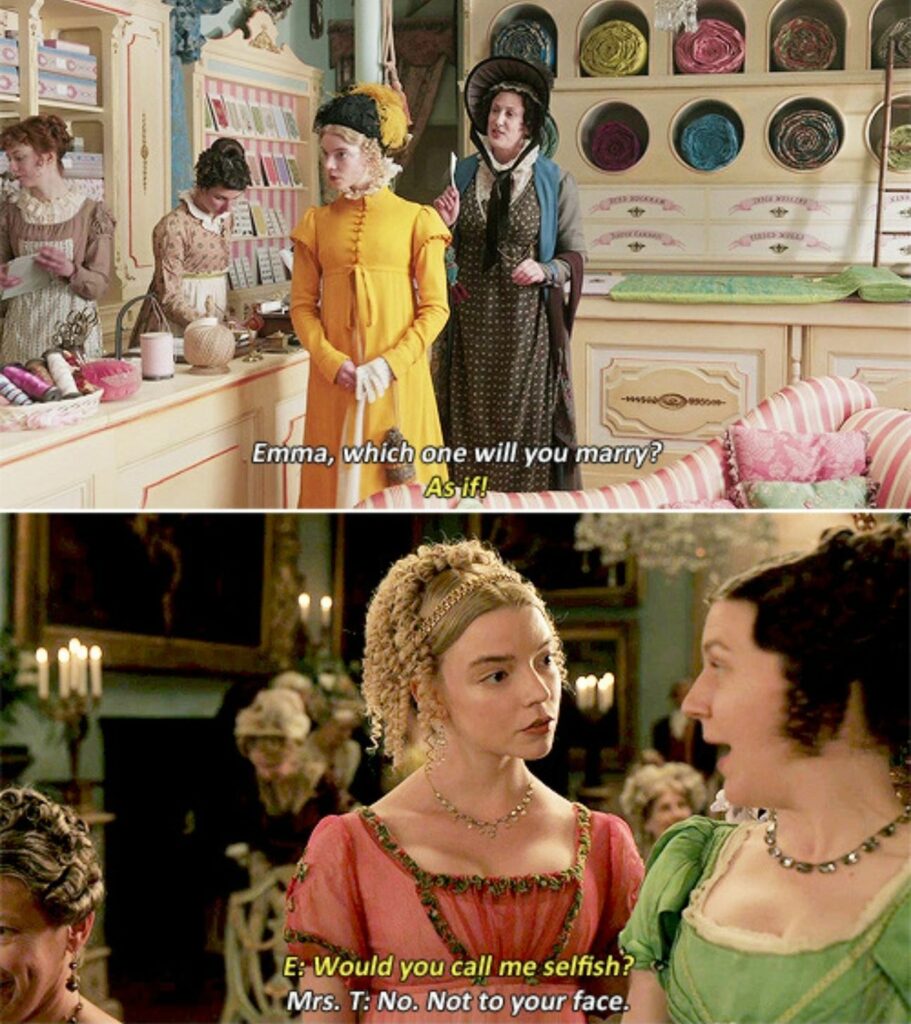


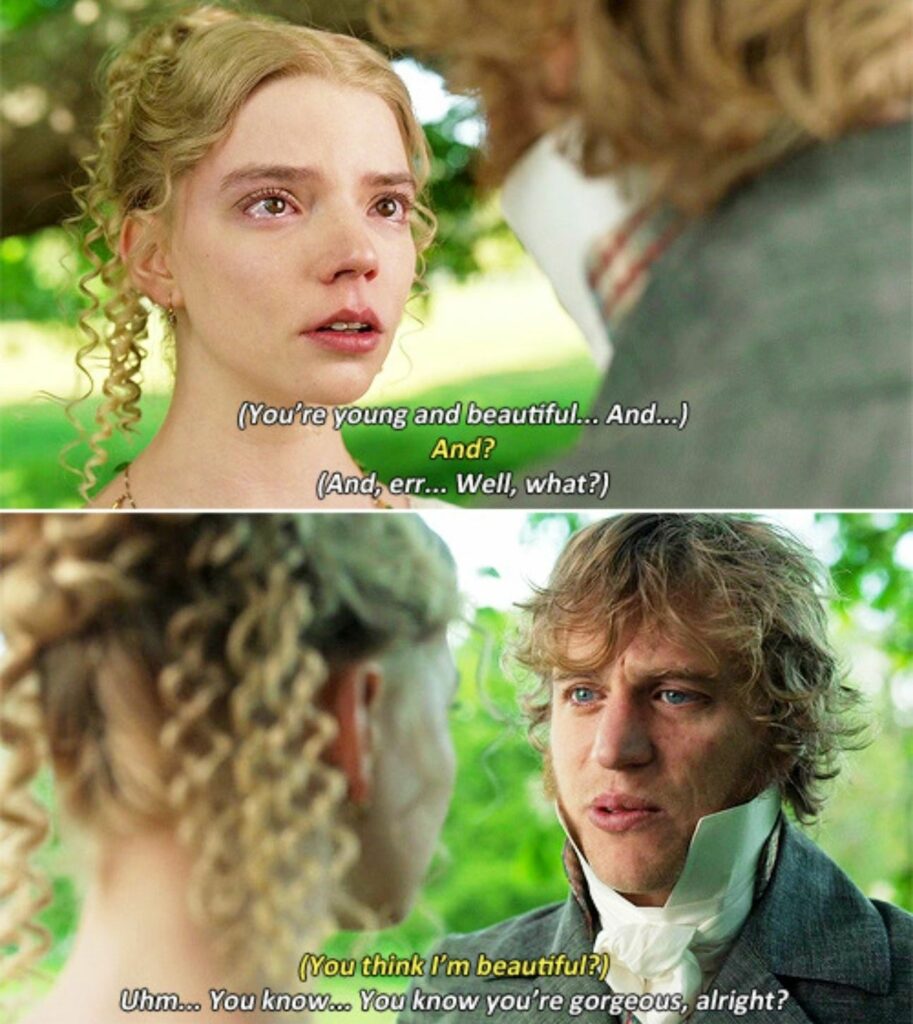
Emma. LP soundtrack album, composed by Isobel Waller-Bridge and David Schweitzer, illustrated by Carson Ellis, 2020.
Autumn de Wilde’s adaptation of Emma utilizes a blend of classical compositions by Waller-Bridge and Schweitzer as well as folk music from Jane Austen’s time period. This contrast highlights the wealth and cultural disparities at play in the film. Several other key artistic choices were made by the director and composers, including the use of a certain instrument to cue in each character — for example, harp music plays upon Emma’s entry into a scene, and a folksy violin plays for Harriet. Every main character also has a theme, and all solos, both instrumental and vocal, are performed by the actors. The art on the vinyl itself makes use of de Wilde’s pastel color palette in softly detailed watercolor. Included with the record is the sheet music for Drink to Me Only with Thine Eyes, alongside a glossy pamphlet of stills from the film, which are decorated by Ellis’s sweet renderings of butterflies and bees.
from the teaching collection of Prof. Juliette Wells
–Lena Brazfield ’23

